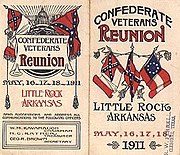The United Confederate Veterans, also known as the UCV, was a veteran's organization for former Confederate soldiers and sailors of the American Civil War and was equivalent to the Grand Army of the Republic (GAR), which was the organization for Union veterans.

Reunion Pamphlet
History[]
Prior to 1889, Confederate veterans had no national organization similar to the Grand Army of the Republic. Several separate fraternal and memorial groups existed on a local and regional level. Meeting in New Orleans, Louisiana, in 1889, several of these groups united and formed the United Confederate Veterans Association. The organization was founded to serve as a benevolent, historical, social and literary association. The UCV was active well into the 1940s. Its final reunion was held in Norfolk, Virginia, in 1951.
The primary functions of the organization were to provide for widows and orphans of former Confederate soldiers, preserve relics and mementos, care for disabled former soldiers, preserve a record of the service of its members, and organize reunions and fraternal gatherings. At its height, membership in the organization was approximately 160,000 former Confederate soldiers organized into 1,885 local camps. A privately produced magazine called Confederate Veteran was popular with UCV members, with articles about events during the war and providing a forum for lost comrades to locate one another.
The organizational structure of the UCV was based on a military-style hierarchy with a national headquarters, three departments, divisions within those departments, and finally the local camps. The national officers were at first known as "Generals Commanding" and later as "Commander-in-Chief." Commanders were not based on the actual rank of the veteran while in service. Commanders-in-Chief ranged from former generals to former privates. Former Confederate General John Brown Gordon was the first commander of the UCV in 1890, holding this position until his death in 1904, when he was succeeded by Stephen D. Lee. Later commanders included former generals Clement A. Evans, William L. Cabell and George W. Gordon.
Commanders in Chief of the United Confederate Veterans[]
- John B. Gordon 1890-1904
- Stephen D. Lee 1904-1908
- William L. Cabell 1908-1909
- Clement A. Evans 1909-1910
- George W. Gordon 1910-1911
- Cornelius I. Walker 1911-1912
- Bennett H. Young 1912-1916
- George P. Harrison 1916-1919
- K.M. Van Zandt 1919-1921
- Julian S. Carr 1921-1923
- William. B. Halderman 1923-1924
- James A. Thomas 1924-1925
- Walker B. Freeman 1925-1926
- Morris .D. Vance 1926-1927
- James C. Foster 1927-1928
- Albert T. Goodwyn 1928-1929
- Richard A. Sneed 1929-1930
- Len W. Stephens 1930-1931
- Charles A. DeSaussure 1931-1932
- Homer T. Atkinson 1932-1934
- Rice A. Pierce 1934-1935
- Harry R. Lee 1935-1936
- Homer T. Atkinson 1936-1937
- John M. Claypool 1937-1938
- John W. Harris 1938-1939
- Julius F. Howell 1939-1941
- John M. Claypool 1941-1942
- John w. Harris 1942-1943
- Homer T. Atkinson 1943-1945
- William Banks 1945-1946
- Henry T. Dowling 1946-1947
- James W. Moore 1947-1948
- William. M. Buck 1948-1949
- James W. Moore 1949-1951
National Reunions[]
The UCV organized many local and national reunions of Confederate veterans. Some of the national reunions attracted thousands of former veterans. In 1875, the Confederate and Union veterans first met in reunion at Bunker Hill. In 1881 Union veterans decorated Confederate graves during Mardi Gras in New Orleans as a sign of respect. Between 1881 and 1887, Federal and Confederate veterans held 24 major reunions together. The 50th anniversary of the Battle of Gettysburg attracted 8,000 Confederate and 44,000 Union veterans. It was common practice for both the GAR and the UCV to produce medals, ribbons, and other assorted memorabilia to commemorate reunions and gatherings. These items are considered collector's items today and are much sought after.

USPOD postage stamp issued May 5, 1951
At its final national reunion in May, 1951, a commemorative postage stamp was issued. It was virtually identical to the one printed in 1949 for the last national encampment of the GAR.
Legacy[]
On July 1, 1896 a successor organization, the United Sons of Confederate Veterans (USCV), later re-designated Sons of Confederate Veterans (SCV) was founded at Richmond, Virginia, to consolidate the patriotic societies then composed of male lineal descendants of Confederate veterans. A similar association comprising female descendants, the United Daughters of the Confederacy, had been organized two years earlier at Nashville, Tennessee.
See also[]
- Grand Army of the Republic
- Military Order of the Stars and Bars
- Sons of Confederate Veterans
- United Daughters of the Confederacy
External links[]
- Footage of the 1914 reunion
- Comprehensive page on UCV reunion in Memphis
- United Confederate Veterans Association Records at the Louisiana State University
- United Confederate Veterans Collection at James Madison University's Special Collections.
The original article can be found at United Confederate Veterans and the edit history here.